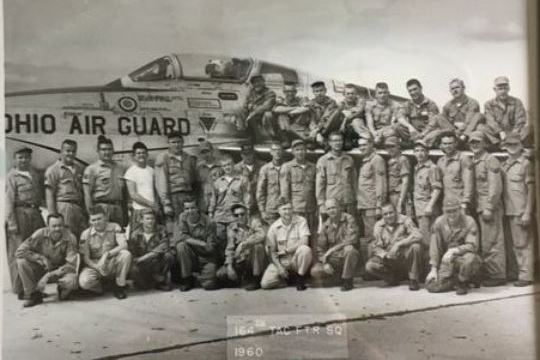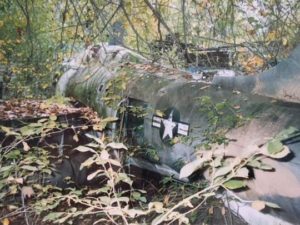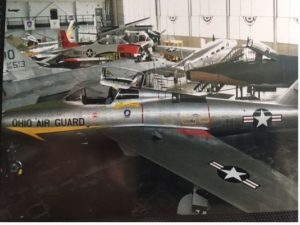The F-84 Thunderjet was a turbojet fighter-bomber aircraft made by Republic Aviation, which was based in Farmingdale, Long Island, New York.
The F-84 was the U.S. Air Force‘s primary strike aircraft during the Korean War, flying 86,408 sorties and destroying 60% of all ground targets in the war as well as eight Soviet-built MiG fighters. Over half of the 7,524 F-84s produced served with NATO nations, and it was the first aircraft to fly with the U.S. Air Force Thunderbirds demonstration team.
The F-84 was the first production fighter aircraft to utilize in-flight refueling, and the first fighter capable of carrying a nuclear weapon, the Mark 7 nuclear bomb.An F-84F aircraft formerly flown by the Ohio Air Guard in Mansfield, Ohio has now been restored. And a local man, Paul Gates–a former aircraft maintenance member of the 164th Tactical Fighter Squadron–helped restore it.
The plane sat forlorn and rusting in a wooded area of Newbury, Ohio for some four decades after having been purchased as scrap.
The restored aircraft was (re)dedicated on July 22, 2017, and it now sits in the MAPS Air Museum outside the Akron/Canton Airport.
MAPS Air Museum is a non-profit organization dedicated to educating people about the history of aviation and its impact upon society. It accomplishes this mission by acquiring, restoring, preserving, studying and exhibiting the impact of aviation on the culture of mankind.Originally known as the Seversky Aircraft Company, Republic Aviation was also responsible for the design and production of many important military aircraft, such as World War II’s P-47 Thunderbolt fighter and the F-105 Thunderchief jet fighters, as well as the A-10 Thunderbolt II close-support aircraft. In July of 1965, the aerospace company Fairchild Hiller, owned by Sherman Fairchild, acquired Republic Aviation.
The F-84 nomenclature can be somewhat confusing. The straight-wing F-84A to F-84E and F-84G models were called the Thunderjet. The F-84F Thunderstreak and RF-84F Thunderflash were different airplanes with swept wings.
Originating as a 1944 United States Army Air Forces (USAAF) proposal for a “day fighter”, the F-84 first flew in 1946. Although it entered service in 1947, the Thunderjet was plagued by so many structural and engine problems that a 1948 U.S. Air Force review declared it unable to execute any aspect of its intended mission and considered canceling the program.
The aircraft was not considered fully operational until the 1949 F-84D model and the design matured only with the definitive F-84G introduced in 1951. In 1954, the straight-wing Thunderjet was joined by the swept-wing F-84F Thunderstreak fighter and RF-84F Thunderflash photo reconnaissance aircraft. Modified F-84s were used in several unusual projects, including the FICON and Tom-Tom dockings to the B-29 Superfortress and B-36 bomber motherships, and the experimental XF-84H Thunderscreech turboprop.
Featured photo shows Madison Township resident Paul Gates (who supplied all photos used in this article) in 1960. He is third from the left, front row. Paul worked in aircraft maintenance in the 164th Tactical Fighter Squadron at Lahm Airport. He helped to restore an F-84F like the one in this photo.



